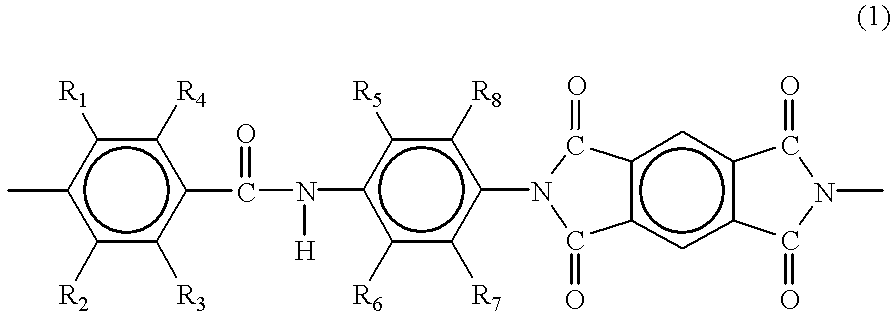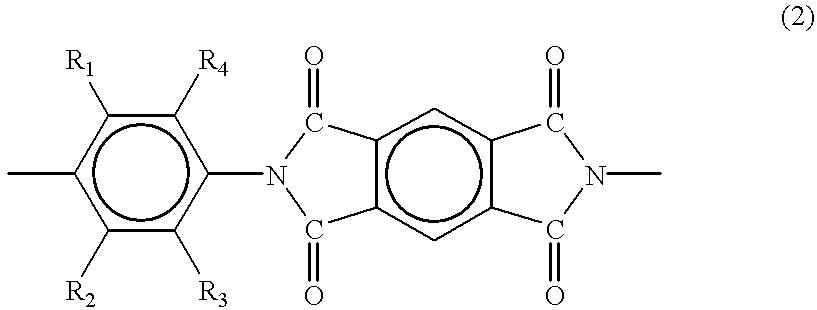Laminate for HDD suspension and its manufacture
a technology of laminates and suspensions, which is applied in the direction of maintaining head carrier alignment, record information storage, synthetic resin layered products, etc., can solve the problems of difficulty in automating steps, non-respect of thermal expansion of polyimides, and the obstacle of conventional gold wires to reduce flying heigh
- Summary
- Abstract
- Description
- Claims
- Application Information
AI Technical Summary
Benefits of technology
Problems solved by technology
Method used
Image
Examples
synthetic example 1
In a 5-l separable flask, 154.4 g (0.60 mole) of MABA and 80.1 g (0.40 mole) of DAPE were dissolved in 2,560 g of DMAc with stirring. The solution was cooled in an ice bath and 218.1 g (1 mole) of PMDA was added with passage of a stream of nitrogen. The solution was allowed to return to room temperature and stirred continuously for 3 hours to effect polymerization. There was obtained a viscous solution of polyimide precursor A.
The solution of polyimide precursor A was applied to a stainless steel foil (tension-annealed SUS 304, product of Nippon Steel Corporation) by an applicator, dried at 130.degree. C. for 30 minutes, then subjected to heat treatment at 160.degree. C. for 4 minutes, at 200.degree. C. for 2 minutes, at 270.degree. C. for 2 minutes, at 320.degree. C. for 2 minutes and at 360.degree. C. for 2 minutes to form a 25 .mu.m-thick layer of polyimides on the stainless steel foil. When the polyimides were immersed in 100% hydrated hydrazine at 50.degree. C. with the stainle...
synthetic example 2
In a 5-l separable flask, 75.7 g (0.7 mole) of PDA and 60.1 g (0.3 mole) of DAPE were dissolved in 2,010 g of DMAc with stirring. The solution was cooled in an ice bath and 218.1 g (1 mole) of PMDA was added with passage of a stream of nitrogen. The solution was allowed to return to room temperature and stirred continuously for 3 hours to effect polymerization. There was obtained a viscous solution of polyimide precursor B. The polyimides prepared from polyimide precursor B in the same manner as in Synthetic Example 1 showed an etching rate of 3.2 .mu.m / min and a linear expansion coefficient of 1.7.times.10.sup.-5 / .degree. C.
synthetic example 3
In a 5-l separable flask, 292.3 g (1 mole) of APB was dissolved in 3,690 g of DMAc with stirring. The solution was cooled in an ice bath and 358.3 g (1 mole) of DSDA was added with passage of a stream of nitrogen. The solution was allowed to return to room temperature and stirred continuously for 3 hours to effect polymerization. There was obtained a viscous solution of polyimide precursor C. The polyimides prepared from polyimide precursor C in the same manner as in Synthetic Example 1 showed an etching rate of 2.3 .mu.m / min and a linear expansion coefficient of 4.8.times.10.sup.-5 / .degree. C.
PUM
| Property | Measurement | Unit |
|---|---|---|
| heat shrinkage | aaaaa | aaaaa |
| roughness | aaaaa | aaaaa |
| Ra | aaaaa | aaaaa |
Abstract
Description
Claims
Application Information
 Login to View More
Login to View More - R&D
- Intellectual Property
- Life Sciences
- Materials
- Tech Scout
- Unparalleled Data Quality
- Higher Quality Content
- 60% Fewer Hallucinations
Browse by: Latest US Patents, China's latest patents, Technical Efficacy Thesaurus, Application Domain, Technology Topic, Popular Technical Reports.
© 2025 PatSnap. All rights reserved.Legal|Privacy policy|Modern Slavery Act Transparency Statement|Sitemap|About US| Contact US: help@patsnap.com



